What's The Difference Between Steak Tartare And Beef Carpaccio?
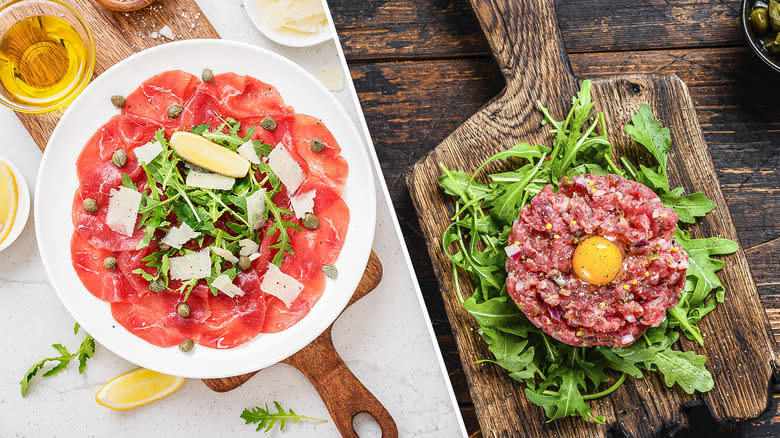
- Oops!Something went wrong.Please try again later.
The increasing love of raw fish in the U.S. through dishes like sushi, poke, and ceviche has led to a lot of people learning the difference between things like sashimi and sushi, yet raw meat dishes like steak tartare and beef carpaccio haven't seen quite the same interest. Maybe it's a feeling that fish are somehow "cleaner" than cows, or maybe it's just a trust of traditional dishes from other countries, but it is a little baffling that the country that produces the most beef in the world hasn't fully embraced its raw forms. It's a shame because raw beef dishes can be incredibly satisfying while presenting a lighter, more unique way to enjoy its delicious, meaty flavor. Steak tartare and beef carpaccio show just how creative and unique you can get with its preparation.
It may seem like splitting hairs to worry about the difference between two raw meat dishes, but as similar as they seem on the surface, eating them brings two quite different experiences. The thinly sliced carpaccio is frequently served with other garnishes and ingredients and is a lighter experience. Steak tartare also has some garnishes but is a richer, heavier mixture of beef and sauces that is usually eaten spooned onto bread or some other eating vessel. Both can be appetizers or a light main course but, more importantly, both are simple and delicious entry points to the world of raw meat.
Read more: The Most Popular Cuts Of Steak Ranked Worst To Best
What Is Beef Carpaccio?
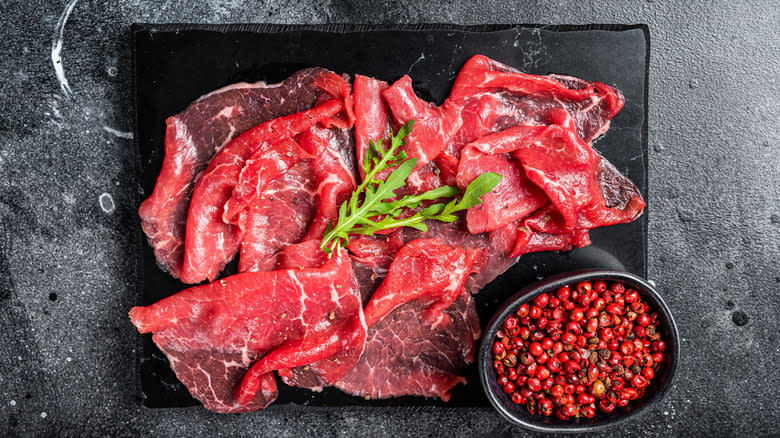
Beef carpaccio is a type of crudo, which means "raw in Italian and Spanish and encompasses a wide variety of uncooked dishes. Carpaccio is a crudo prepared through extremely thin slicing. Carpaccio dishes don't have to be beef, they can be fish or vegetables too, but they are always prepared to be as thin as possible, sometimes to the point of transparency. This occasionally involves not just slicing the meat but also pounding it even flatter than cutting usually allows. Carpaccio dishes usually involve simple toppings and accompaniments to accent the flavor of the central ingredients. Beef carpaccio is often seasoned with salt and pepper along with drizzles of things like olive oil and lemon juice and simple garnishes like onion, capers, parsley, or grated parmesan cheese.
As both the name and the flavoring ingredients would imply, beef carpaccio originally comes from Italy, but it's quite a recent creation. The dish was created in 1950 by Giuseppe Cipriani of Harry's Bar in Venice with the original purpose of being served to a countess who couldn't eat cooked meat. It's named after the painter Vittore Carpaccio, who used intense red colors that reminded Cipriani of the raw beef in the dish, much like another artist inspired him to create the Bellini. The original recipe was only topped with a simple, secret dressing, but as beef carpaccio spread around the world, it came to be served with light toppings like arugula or sliced artichokes.
What Is Steak Tartare?
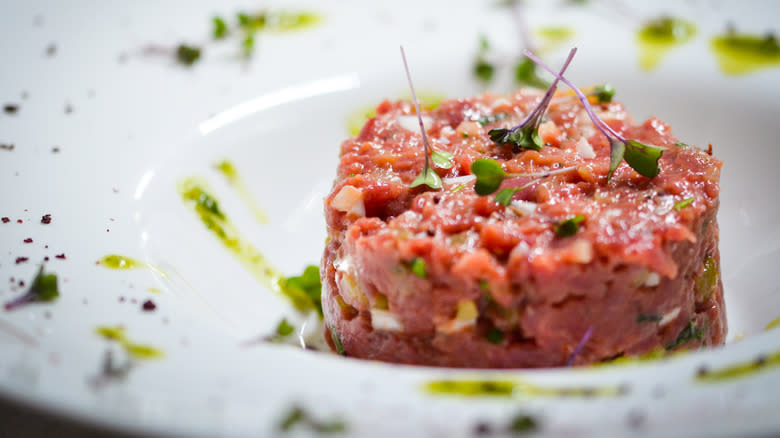
Steak tartare, like beef carpaccio, is a type of crudo that can also be made with any raw ingredient, not just beef. Tartare is prepared by chopping the meat, fish, or vegetable into small cubes, which are then mixed with a sauce or dressing to help the dish bind together and retain its shape. Steak tartare utilizes a wide variety of sauces and extra ingredients and can vary greatly in taste. A common topping is egg yolk, but tartare can be flavored with anything from Worcestershire or Tabasco to mustard and pickles.
The origins of steak tartare are much less clear than beef carpaccio. According to the New York Times, there were rumors that it traced 800 years back to the Mongols (whom Europeans referred to as Tartars) and originated from a custom of carrying raw meat under a horse's saddle that would be tenderized as the riders traveled. This appears to be a myth, but that story may have come from the fact that horsemeat — which was eaten in France because of beef shortages during the Franco-Prussian war — was the original form of tartare.
What we know for sure is that steak tartare became popular in early 20th-century French bistros under the name Beefsteack à l'Americaine, or "steak in the American style," supposedly because of the belief that Americans ate raw meat. It was originally served with tartar sauce, which is the most clear explanation for the name.
Beef Carpaccio Usually Has A Brighter, Lighter Flavor
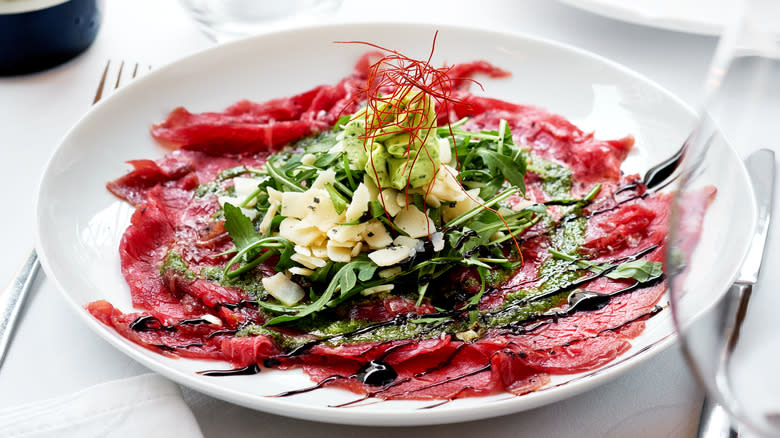
Despite both steak tartare and beef carpaccio being heavily based on raw beef, they can have remarkably different flavors. The light, simple accentuations of beef carpaccio really highlight the taste of the raw beef. The extra ingredients that are used, from citrus juice to herbs and greens, tend to lean towards the brighter end of the spectrum. That gives beef carpaccio a very clean and light taste that lets eaters experience the more subtle complexities of the beef. On the occasions that more intensely flavored additions are part of the recipe — which can be things like a lemon vinaigrette or honey balsamic glaze — a light hand should still be used.
Steak tartare usually has a much richer, more savory flavor than carpaccio. Even though tartar sauce is no longer the standard condiment, fatty additions like Dijonnaise are common, either as mix-ins for the tartare itself or spread on bread with the steak. Worcestershire or anchovies can bring an extra umami boost that somehow makes the steak taste even more meaty. The resulting flavor is deliberately decadent with a more complex, over-the-top mix of flavors than the beef-forward carpaccio.
Steak Tartare Is Chopped And Creamy
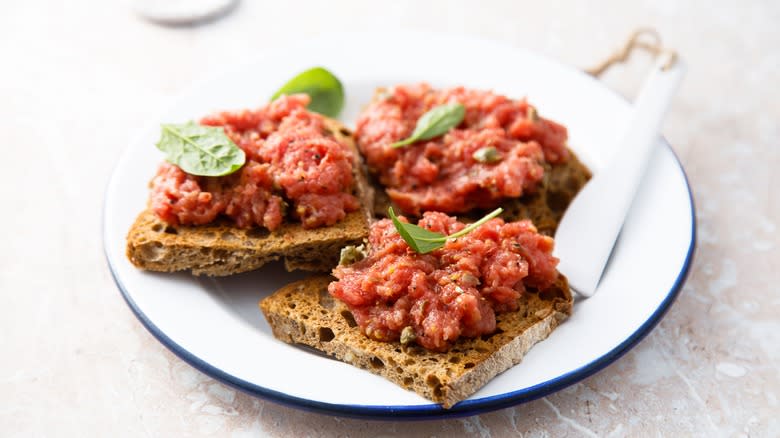
While the light vs. rich flavor of beef carpaccio and steak tartare is the clearest difference, the way the beef itself is prepared also has a huge effect on the taste experience and is the obvious visual distinguisher between the two. Steak tartare is cut down into small cubes and mashed together into a pile, which almost resembles an uncooked burger. The minced texture of tartare adds to the creamy mouthfeel of the dish, which complements the other bold, fatty ingredients. When making good steak tartare, it should still retain the distinct chew of raw beef rather than devolve into mush, but the preparation softens it into something closer to a spread than a steak.
Carpaccio is much more delicate. In order to get the near-impossibly thin slices, the beef can be frozen to make cutting easier, or you may even need an electric meat slicer. Because the beef is being sliced into sheets, the fat also needs to be trimmed to make it easier to chew. The lightness of the flavors is mirrored in the texture of the beef itself. The thin sheets and fat trimming also make carpaccio a much more lean-tasting dish.
Both Commonly Use The Same Cuts Of Beef
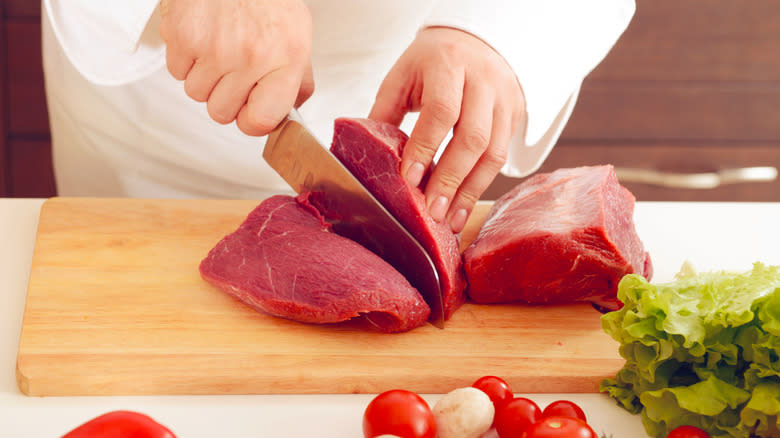
Despite the significant differences in taste and texture between steak tartare and beef carpaccio, one big thing they do share is that the ideal cuts of beef for both are the same. Just about any recipe you find for either dish will call for sirloin, tenderloin, or filet mignon, which is the end piece of the larger tenderloin. These three cuts all share two important characteristics for raw beef dishes: They are lean and are some of the most tender cuts on the cow.
The sirloin and tenderloin are next to each other and come from an area of the cow that doesn't bear much weight or do much work, which keeps the meat extra supple. The tenderloin and filet are the prime choices for tartare and carpaccio as the most tender options you can buy, but sirloin has an inexpensive beef cut that can fill the same role. The tenderness and lack of fat in these cuts are essential for being able to chew them without any cooking.
Well-marbled beef is normally the most sought-after for steaks because of the rich flavors, but without heat to melt the fat, it remains too tough. That you can get such different experiences in raw beef dishes from these same cuts shows the amazing creative potential that raw meat has. Here's to hoping it gains the kind of acceptance that raw fish has already found.
Read the original article on Tasting Table.

